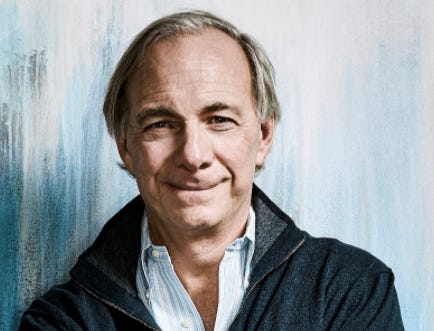Understanding global finance and entropy
Tooze, Dalio, and West <> An attempt to explain finance and economics through the lens of biology

I’m in a book club with a group of interesting capitalists. To paint a quick picture of each person’s background, the group consists of:
A senior policy analyst to a state Governor
Two hedge fund currency traders
An investment banker
Two startup tech founders
The group cares about understanding how the world works, and our collective curiosity has pushed us to study subjects like human behavior, free will, financial systems, political philosophy, and so forth.
Our most recent book was Adam Tooze’s Crashed, which explores in wide-ranging detail the Great Recession of 2008 — its causes, its acute impacts, and speculation around its continuing implications.

Adam Tooze
Tooze makes a number of arguments, which I think can be synthesized as follows:
The Great Recession cannot be understood as an isolated American event. Instead, it must be understood as exceptionally global in nature
The Great Recession would have been the Great Depression II, had it not been for massive intervention from the US Fed to provide dollar liquidity to both the megabanks, and to other central banks
To view macroeconomics through the traditional narratives of national debts and deficits is to perpetuate obsolete frameworks for understanding the relationship between nations, banks, and corporations. Instead, macroeconomics are better understood through the lens of global financialization
Because modern financial architecture is inextricably global, its scale and complexity make it crisis prone. In other words, global finance is a massively complex tinderbox that is highly influenced by human psychology and therefore produces a lot of entropy
That crisis (at least in the short-term) can be expediently managed and mitigated if the system has access to liquidity (e.g. US Fed printing money), but that the degree to which we understand the implications of this crisis fighting technique is limited
That for now and probably well into the 21st century, the dollar is the reserve currency and the US Fed is the de facto piggybank of the global financial system — meaning that the US Fed is the crisis management agency for the global financial system, and will play this role by ensuring global liquidity whenever systemic failure threatens.
In trying to further synthesize multiple, but interdependent theses, I’ve turned to biological analogy. Another way to try to encompass Tooze’s narrative is to consider the global financial system as an organism that is growing exponentially. Its heart is the US Fed, pumping dollars into the system to fuel the organism’s high metabolic rate. Sometimes, the organism gets sick, and needs even more dollars pumped into its bloodstream to help it survive its illness. Its illnesses are generally caused by several types of issues:
Substantial organ failure (e.g. the Eurozone’s failure might be akin to liver failure)
Metastasizing tumor (e.g. U.S. subprime mortgage crisis)
Black swan event (e.g. COVID-19)
Viral or bacterial infection (e.g. conflict, often geopolitical in nature)
Irrational anxiety and fear (e.g. herd mentality, bank runs, etc)
Tooze illustrates the scale of both the crisis and the subsequent crisis-fighting policies in such a way as to make them feel unbelievable, and it’s impossible to read the book and not wonder about how a system of such enormity and complexity (and of such chronic health risk) is able to persist. Indeed the one question I tried to press upon our book club was, “does the music ever stop?”
Surely, I thought, the world can’t rely on debt-fueled growth forever. And surely, we can’t print our way out of every financial crisis from here on out? Surely inflation will make this impossible? Surely, because of how prone crisis fighting techniques are to politics, there will come a day when the US Fed isn’t there to play doctor? Surely a system of this proportion and complexity must eventually produce so much entropy that it has to explode or implode?
West & Dalio
In trying to satisfy these questions, I turned to two thinkers, who have spent much of their careers working to understand how entropy affects systems:
First, Geoffrey West, the theoretical physicist, who has written extensively on the laws of scale. His examinations approach entropy through the lens of mammals, companies, and cities.

Geoffrey West
Second, Ray Dalio, who has written extensively on the history of debt and currencies. His examinations approach entropy through the acute lens of financial cycles.

Ray Dalio
Scale & Entropy
Geoffrey West, in the latter stages of his career, became fascinated by aging and mortality and began examining questions, such as:
“Why do we live as long as we do, and no longer?”
“Why do mice live for just 2–3 years, whereas elephants live for up to 75? And despite this difference, why is the number of heartbeats in a life span roughly the same for elephants, mice, and all mammals, namely, about 1.5 billion?”
“Why do almost all companies live for only a relatively few years, whereas cities keep growing and manage to circumvent the apparently inevitable fate that befalls even the mots powerful and seemingly invulnerable companies?”
“Why does the pace of life continually increase, and why does the rate of innovation have to continue to accelerate in order to sustain socioeconomic life?”
“Can we maintain a vibrant, innovative society driven by ideas and wealth creation, or are we destined to become a planet of slums, conflict, and devastation?”
West explores these questions in his book Scale, which explains universal laws about life, growth, and death. He finds that mammals, are to a large degree scaled versions of each other (e.g. mice and humans are made of the same stuff and have the same number of heart beats throughout lifespans of quite different scale). And then he goes on to explore the degree to which those biological laws of nature hold true when applied to cities and companies.
“Scaling,” he writes, “in its most elemental form, refers to how a system responds when its size changes.” And illuminated throughout his work is the truth that companies and organisms live, grow, and die in relatively predictable cycles of innovation followed by entropic decay, whereas cities seem capable of living on forever.
Essential to the understanding of scale is the understanding of the second law of thermodynamics and entropy, “the fundamental property of the universe.”
The second law of thermodynamics (2ndLTD) rules the world. It states that entropy (disorder) in a closed system (e.g. an organism, or a company) will always increase, and it’s so ironclad that Einstein said that it was the only theory he believed would never be disproven.

Entropy is a measure of uncertainty. It’s also defined as lack of order, or in other words chaos. Another way to think about entropy is to visualize it as energy that cannot be used productively. As a city produces innovation, art, wealth, culture, so to does it produce crime, poverty, disease and environmental degradation. As an animal consumes calories to survive, so does the very act of survival increase the entropy that will eventually destroy it. An athlete trains to ward off physical degeneration, but over time, all of that exercise also contributes to wear and tear that inevitably serves to introduce more chaos to the athlete’s system, which will eventually result in athletic decline.
Debt Cycles & Currency Devaluation
Ray Dalio is a well-known hedge fund investor, and over the last few years has become popular through his writings about principles for life and work, and also his linkedin posts about debt cycles and paradigm shifts.
Dalio believes that history has shown that debt is cyclical, bubbling and bursting in clear episodic patterns, and also that all currencies die. In this vein, West’s observations are helpful to remember. Cities (and some mythologies) — not companies, organisms, or currencies — are the only complex systems that stand the test of time.
If the global financial system has grown inexorably more complex and massive since the end of Bretton Woods in 1971, and if the system has reached a point, as Tooze argues, that is now inherently prone to chronic crises, and if to fight these crises, the US Fed must be prepared to inject newly printed dollars into the system (as though dollars are both morphine and adrenaline, dampening our pain and elevating our self-confidence), then to what degree are we now living in a period of rapidly rising entropy and subsequent socioeconomic decline?
I think Dalio would answer that question with a bell curve diagram he’s used in an article on money, credit, and debt.

First, he’d argue that we are in the late stages of a debt cycle. We know this, because currencies (e.g. dollar, yen, and euro) are in late stages of long-term debt cycles when there is a lot of debt, the interest rate compensation for holding this debt is low (so not attractive), and more and more debt is being created, despite the low interest rates, which means that the borrowing is being fueled not by capitalists (who now have little incentive due to low interest rates) and instead by central banks, whose incentive is to prop up the cycle and prevent painful restructuring.
Second, he’d explain how we got here. He’d remind us that debt crises happen throughout history. They’re episodic, not revolutionary, and they tend to cluster around wars or financial crises. These events require countries to run huge deficits. In these moments, policy makers have 4 levers they can pull to deal with the debt crisis (see table below):

As Tooze illustrates in Crashed, policy makers in 2008 and afterward, chose the 4th lever. The US Fed printed dollars and pumped them into the global financial system via bank bailouts and swap lines with other central banks. In doing so, they prevented a great depression. Neither debtors, nor creditors were wiped out, and the liquidity relief the Fed pumped into the system was reinvested in productive ways that led to stock market surges. This allowed main street investors, who measure their wealth against stock market indexes, to feel that they were getting richer over the next decade.
As Tooze argues, a crisis averted. As Dalio argues, a crisis delayed. Remember Dalio believes we are now in the late stages of a debt cycle, in which so much money has been printed that extreme currency devaluation threatens. Sooner rather than later, there will be debt restructuring and the emergence of a new world order. How and when exactly that will play out, we can’t know, but for Dalio, the devaluation or elimination of the dollar as the reserve currency would be “the most disruptive economic event we could imagine.” In other words, the music would definitely stop.
But does it really?
Still though, I’m dissatisfied. Dalio shows us that debt cycles lead to currency devaluation and new financial world orders episodically.
West reminds us that the second law of thermodynamics governs the universe. Eventually the entropy created by the modern global financial system will cause it to implode or explode.
Tooze shows us that printing money is the essential tool for fighting the chronic crises of the modern global financial system and that we have to graduate from the idea that macroeconomics are explained by national debts and embrace the new reality that macroeconomics are best explained by an underpinning financial networking that powers socio economic organization. The actions taken in 2008, produced, well, awesome results — a Great Depression avoided, followed by a spectacular ten-year bull market.
How do we reconcile the essential crisis-fighting mechanism and a new explanation for macroeconomics with underlying laws of nature and clear historical cycles?
The thought that’s occurred to me in trying to make sense of this question is that reconciliation might depend on how we view the global financial system.
If we view the global financial system through the original biological analogy — an organism whose heart is the US Fed and whose diseases are relatively predictable — then, inevitably the organism must die as entropy increases. In this line of thought, currency devaluation will happen when debt bubbles burst, the modern financial system as we know it will implode, and a new order will be ushered in.
But does this analogy may be problematic by not viewing the global financial order as a system on a continuum. Perhaps a more appropriate analogy for understanding global finance is to consider it as a megacity located in a temperate climate — a sprawling network of suburbs and population clusters, dealing constantly with summers and winters, springs and falls, capital and poverty, art and crime, and most importantly, innovation from the bottoms up, more so than from the top down, that serves to prevent it from ever dying.
If the global financial system is more similar to a city than it is to an organism or a company, then the music never stops, and instead, its tune simply changes with the times.
